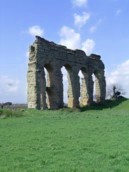Pax Romana
(Lecture Notes from Mr. Kersey's 7th Grade Geography, History, and Culture Class) The Pax Romana, or "peace of Rome," began shortly after the end of the Republic and the beginning
of the imperial period of Roman history. After Julius Caesar was assassinated on the floor of the Roman
Senate on the Ides of March, or March 15, 44 B.C., a new person named Octavian quickly rose to power, and
became the first "official" Roman emperor. Later, Octavian took the name Augustus Caesar or, if you've
got a few extra minutes, Imperator Caesar Divi Filius Augustus. The changes Augustus made to the
empire lasted more than two hundred years, and marked the beginning of the Pax Romana.
The Pax Romana, or "peace of Rome," began shortly after the end of the Republic and the beginning
of the imperial period of Roman history. After Julius Caesar was assassinated on the floor of the Roman
Senate on the Ides of March, or March 15, 44 B.C., a new person named Octavian quickly rose to power, and
became the first "official" Roman emperor. Later, Octavian took the name Augustus Caesar or, if you've
got a few extra minutes, Imperator Caesar Divi Filius Augustus. The changes Augustus made to the
empire lasted more than two hundred years, and marked the beginning of the Pax Romana.
During the Pax Romana, life was comfortable for many Romans and for many of the people they ruled. The empire included the lands around the Mediterranean Sea as well as much of Western Europe. Roman and Greek culture spread throughout the lands. Some major contributions of the Roman Empire during the peace of Rome are below.
Government
Since the empire was now controlled by a single emperor, control of the large empire improved. Government workers were employed to enforce policies, and that left the Romans soldiers to be soldiers. The government became more organized.Laws
The Romans had a system of written laws, which was a big deal. Everyone knew what the laws were, and they were pretty much the same for everyone. The Romans had laws that covered all sorts of things and many of our laws today a based on the Roman examples. They even had lawyers to interpret them for the people.Architecture/Engineering
 The Romans were master designers and builders. They created roads all over the empire and it wasn't long
before people could rightly say "All roads lead to Rome," because if it was a road built by the Romans, it
did. Many Roman roads can still be seen today. The Romans also had fresh water running from the mountains to their cities via aqueducts, as well as
running water and sewage systems for the wealthy. Some homes even had central heating systems.
The Romans were master designers and builders. They created roads all over the empire and it wasn't long
before people could rightly say "All roads lead to Rome," because if it was a road built by the Romans, it
did. Many Roman roads can still be seen today. The Romans also had fresh water running from the mountains to their cities via aqueducts, as well as
running water and sewage systems for the wealthy. Some homes even had central heating systems.
Language
The Roman language, Latin, is still taught today, even though no one speaks it. That goes to show you haw much of an influence it was. The modern day languages of Spanish, French, Italian, and Portuguese are all based on the language of Latin. The Latin alphabet became the basis for most western alphabets as well.The Romans also had an influence in the areas of art, literature, and religion. Many of these influences came about or were further developed during the Pax Romana.

